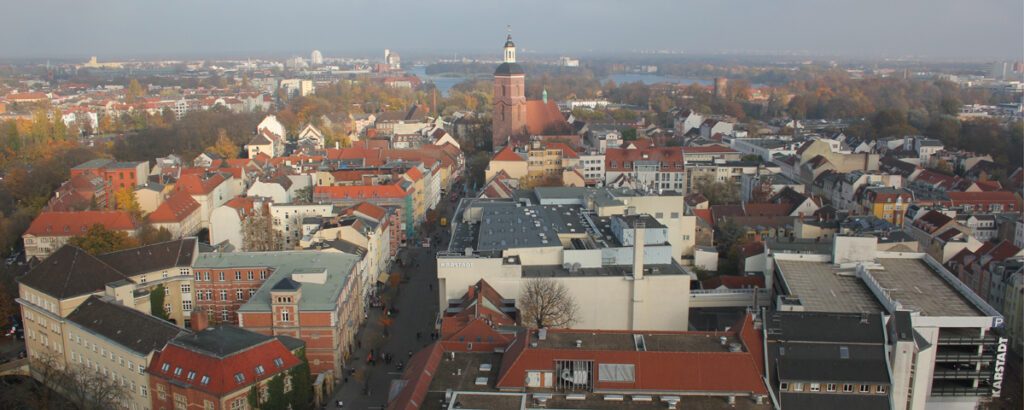Solarcity: Study on the potential for photovoltaics in the old town of Spandau

Project description
In the project “Solar Study Old Town Spandau”, RLI determined the potential for photovoltaics on the roof surfaces of the old town of Spandau.
The city of Berlin has set itself the goal of becoming climate-neutral by 2050. To achieve this, renewable energy in the city must be expanded considerably. In densely built-up urban areas, solar energy is usually the best option for generating electricity from renewable sources – the many roof surfaces are ideal locations for photovoltaic systems. Based on a study by the Fraunhofer Institute for Solar Energy System (ISE), which determined Berlin’s solar power potential at 25 percent, a photovoltaic capacity of 4,400 MWp would have to be installed in Berlin by the target year 2050 to be able to generate around 4,000 GWh of solar power each year.
These goals are implemented in the Masterplan Solarcity Berlin, which was ratified by the Berlin Senate in March 2020. Almost all departments of the Berlin administration are contributing to this plan.
Analysis of potential in several steps
The Berlin districts independently check where suitable roof areas for photovoltaics are located and how homeowners can be supported in making use of them. In case of the old town of Spandau, the RLI Research Unit Transformation of Energy Systems took on the task of determining the demand and the existing potential. For this purpose, existing photovoltaic systems in the old town were identified, their current output was determined, and the roof surfaces that were potentially suitable were evaluated. In addition, a detailed investigation was carried out for four private and three district-owned buildings to determine how solar systems can be installed and operated.
What do suitable roofs for photovoltaic systems look like?
Criteria used to assess the suitability of a roof surface for generating electricity with photovoltaics include its size, any obstacles such as chimneys or skylights, the direction in which the roof is facing, the general condition and load-bearing capacity of the roof, and any restrictions imposed by historic preservation rules.
Historic preservation is not an exclusion criterion
The old town of Spandau has the special feature of a large stock of historical buildings, some of which are listed as cultural heritage and therefore fall under historic preservation rules. This also applies to two of the public buildings, which are examined in detail. Consideration of the protection of historical monuments is an explicit part of the study in order to gain insights into how such special structural conditions and climate protection can be reconciled.
Project duration: September 2019 – July 2020
Tasks
- Determination of the power requirements:Preparation of current load profiles (15-minute values) for each building block in the old town of Spandau
- Recording of the inventory of photovoltaic systems (data sources: Core energy market data register and aerial photographs)
- Calculation of typical production time series for each plant, each block, and the entire area
- Determination of suitable roof areas as well as the expected generation capacity there (data sources: Solar Atlas Berlin and Spandau District Office)
- Detailed considerations for the construction and operation of PV systems on four private and three district-owned buildings
Results
- Status Quo: The photovoltaic stock of the Old Town of Spandau in 2020 covers only 0.1 % of the total power consumption of 12.2 GWh
- The technical photovoltaic potential of the old town of Spandau is up to 3.54 MWp, which allows a theoretical annual power generation of 2.9 GWh.
- After excluding buildings classified as unsuitable for economic and regulatory reasons, a potential of up to 2.53 MWp, or 2.1 GWh remains, which would allow coverage of approx. 17.5 % of the total electricity consumption of the Old Town of Spandau.
- Suitability of the buildings in the old town of Spandau for solar power generation:
- Very suitable: 14 %
- Suitable: 37 %
- Suitable under certain circumstances: 14 %
- Not suitable: 35 %
- The main exclusion criteria for buildings were:Obstructive roof structures (approx. 50 % of unsuitable buildings)
Historic preservation requirements (approx. 1/3 of unsuitable buildings) - The high proportion of listed buildings poses the greatest challenges, but in many cases it is still possible to realize PV projects.
- Operation models for own consumption and tenant flow were economically feasible in all cases, whereby the tenant flow model is strongly dependent on the number of participating tenants.
- A high proportion of own use of the electricity is generally recommended.
- A system amortization with a full feed-in model was not possible in any of the detailed considerations.
- The operation of a storage facility was not or only marginally economical in the cases considered.
- For plants that are only slightly larger than 10 kW, a limitation of the plant capacity to 10 kW is sometimes more economical. The reason: higher feed-in tariffs and omission of the proportionate EEG levy.
- Even with a small roof and high shading, an amortization of the system was realistic in the cases considered with the own consumption model and correspondingly high own use of the electricity.

